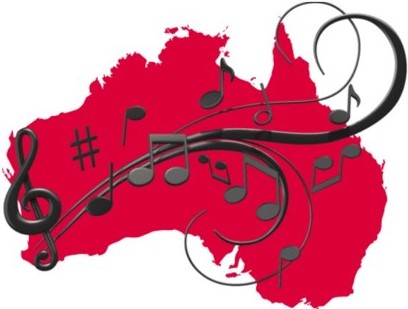Hope your weekend has been groovy and if you live in the U.S. is extended through Tuesday, the Fourth of July holiday. For the 125th time (yep, time flies!), I’d like to invite you on a trip to visit music in different flavors from six different decades. For this milestone installment, I decided to pick another geographic destination, coz why not! Today, we shall all travel to a land down under!
Graeme Bell and his Australian Jazz Band/Mississippi Mud
Our first stop is the year 1950 and music by Australian Dixieland pianist, composer and band leader Graeme Bell. Active from 1935 until 2008, Bell was one of the leading promotors of jazz down under. He also had the distinction of being the first Australian jazz band leader who was still playing at 90 years and the first Westerner to lead a jazz band to China. Bell who started piano lessons in classical music as a 12-year-old began playing jazz in 1935 when he was 21 years old. Six years later, he led his first own group Graeme Bell Jazz Gang. Since late 1946 Bell’s group was known as the Australian Jazz Band. Mississippi Mud, a great Dixieland composition by Harry Barris, appeared as a 10″ 78 RPM in 1950. Feel free to snip along!
Men At Work/Dr. Heckyll & Mr. Jive
Next, we set our time machine to April 1983, which saw the release of the second studio album by another great band from a land down under: Men At Work. Formed in Melbourne in 1978 and led by lead vocalist and guitarist Colin Hay, the group released their debut album Business As Usual in November 1981 in Australia. It brought them huge success right out of the gate, topping the charts in Australia, New Zealand, Norway, the UK and the US, and became their best-selling album. Off their follow-on Cargo, which also did pretty well, here’s one of my favorite Men At Work tunes: Dr. Heckyll & Mr. Jive, a parody of the Robert Louis Stevenson 1886 novella The Strange Case of Dr Jekyll and Mr Hyde.
Nick Cave & The Bad Seeds/Jubilee Street
Time to travel back to the current century, more specifically to February 2013. This is when Nick Cave & The Bad Seeds released their 15th studio album Push the Sky Away. By that time, the group was in their 30th year, and Cave (vocals, piano) and Barry Adamson (bass, backing vocals) who had returned were the only original members. AllMusic calls them “one of the most original and celebrated bands of the post-punk and alternative rock eras in the ’80s and onward.” Jubilee Street was co-written by Cave and band member and multi-instrumentalist Warren Ellis, with lyrics by Cave.
The Easybeats/Sorry
One of the great ’60s Australian bands were The Easybeats, formed in Sydney in late 1964. Their level of success in their home country rivaled The Beatles, and in 1966, they became the first Australian group to score an international hit with their single Friday On My Mind. The catchy tune became their second in a row to top the charts in Australia. Elsewhere, it reached no. 2 in New Zealand, no. 6 in the UK, no. 13 in Canada and no. 16 in the U.S. This brings us to their first no. 1 in Australia, Sorry, which appeared on their third album Volume 3, released in November 1966 – perhaps not quite as catchy as Friday On My Mind, but still another great tune!
Hoodoo Gurus/The Right Time
For our next stop, we shall jump 28 years to July 1994 and music by Hoodoo Gurus, who were formed in Sydney in 1981. Their popularity peaked in the mid-to-late 1980s with albums Mars Needs Guitars!, Blow Your Cool! and Magnum Cum Louder. After a five-year hiatus, they reunited in 2003 and remain active to this day. The Right Time, written by the band’s only constant member Dave Faulkner, appeared on their sixth studio album Crank – great melodic rock song! And how about the band’s cool attention-grabbing cool name!
AC/DC/It’s a Long Way to the Top (If You Wanna Rock ‘N’ Roll)
Once again, we’re reaching our final stop. Let’s end it with a big bang by what I feel is Australia’s ultimate rock & roll band: AC/DC. They were formed in Sydney in 1973 by Scottish-born brothers Malcolm Young (rhythm guitar) and Angus Young (lead guitar). Their first two albums, High Voltage (February 1975) and T.N.T. (December 1975), were released in Australia only. In May 1976, their first international album appeared. Also titled High Voltage, it combined songs from their first two Australian albums. One of the tracks is It’s a Long Way to the Top (If You Wanna Rock ‘N’ Roll). Co-written by the Young brothers and lead vocalist Bon Scott, the tune initially appeared on T.N.T. This anthem just r.o.c.k.s.!!!
And there you have it, folks. Wait, I won’t leave you without a Spotify playlist of the above goodies. Hope there’s something there you dig!
Sources: Wikipedia; YouTube; Spotify







